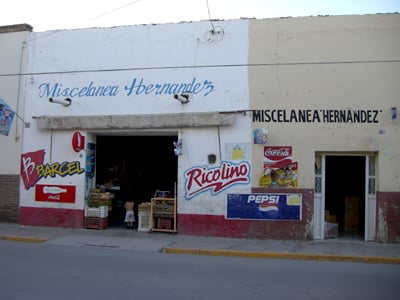Photovoltaic Feasibility Study for Local Grocer:

Jose Leandro Hernandez, a local grocer in Parras, Coahuila MX, is interested in harnessing the ample year-round sunshine that Parras receives to power his store. The grocer is willing to invest in a photovoltaic system, but first needs to determine the economic feasibility of the project. Our goal was to design a system suited to the grocer´s needs and conduct a thorough study to determine the feasibility of the project. We first designed a stand-alone system and found that the payback time is more than 25 years (the expected life of the system). We then designed a grid intertie system with a payback of 11 years. The stand alone system has more components and is far more expensive than the grid intertie system. With the intertie system, the grocer could produce more energy than he uses during the day and feed that energy into the grid (saving a lot of money on batteries) and then draw a similar amount of energy back from the grid at night when the panels aren't producing. Unfortunately, grid intertie systems aren't legal in Mexico. Since the grocer can't afford the stand alone system, we put our efforts into a feasibility comparison between the two systems. With the help of Jose Leandro, we plan to send a petition complete with the two feasibility studies to the Federal Energy Commission in hopes of eventually legalizing grid intertie systems. The Federal Energy Commission is currently considering legalizing intertie systems and giving credit for energy produced and fed into the grid, so that at the end of the month the owner of a PV system will pay only for energy used that his system didn't produce. Our hope is that the feasibility studies and petition will help sway their decision. Since the system won't be built until next summer (when another troupe of Lonny Grafman's students from HSU bombard this city), we are pushing ahead with the grid intertie and petition. It's hard to judge how slim the chance of legalizing these systems is. It is happening with at least one high-profile pilot project in Coahuila, and the most recent revision of energy laws included mandates to encourage local renewable energy generation. And if it all fails, next year's program can easily modify our design to a "peak shaving" system, where the panels produce only enough energy for daytime loads and the grid supplies the nightime demand.
Method
Our first task was to discover the energy demand of his business. It was difficult to determine at first, since his house and the store were both connected. But he gave Mel and I a copy of his highest bill of the year, and we went from there. We decided to go through the store and do an energy audit just to make sure that the bill was really the highest demand. it wasn't too difficult considering that he didn't run much in his store. We came to some pretty close numbers, and decided to run with it.
| Load | Run Watts | Hours/day | Days/week | Total wattage |
| Criotec Refrigerator | 460 | 6 | 7 | ? |
| LaLa Refrigerator | 498 | 6 | 7 | ? |
| Freezer | 460 | 8 | 7 | ? |
| Television | 60 | 8 | 7 | ? |
| T8 Lights X 4 | 128 | 6 | 7 | ? |
| CFL Light | 24 | 6 | 7 | ? |
| Total: ? |
Our next task was to hit up the Comisión Federal de Electricidad, to see if grid-intertie is legal in Mexico. After much research we found that connection to the grid to draw power when the PV system isn´t meeting the demand is legal, but feeding excess energy into the grid is not. We thus decided to design two systems (one with batteries and one with a manual switch to use grid power in absence of sun) and do a feasibility study for each. We then had to search for the peak sun hours of Parras. There's some information about Saltillo and Monterrey, but since Parras is such a small town, it was difficult to track down the information we needed. It wasn't until we were able use RET Screen and the NASA website that we had breakthrough.
Materials
We decided to source the materials from the system from Mexico, if possible. That was difficult. Based on the energy need of the store, we wanted to use some kind of 12V battery. Using the RET Screen System made things a lot easier for us. We were able to input the battery size and price, and even calculate the effect of the tilt of the sun during the year.
Results
Gallery
-
Fig 1: Taking measurements on the far rooftop.
-
Fig 2: Taking measurements on the tallest rooftop.
-
Fig 3: The smallest rooftop.
-
Fig 4: The door to the store.
-
Fig 5: The circuit breaker where the PV system will tie in.
-
Fig 6: The Kw meter at the store.





